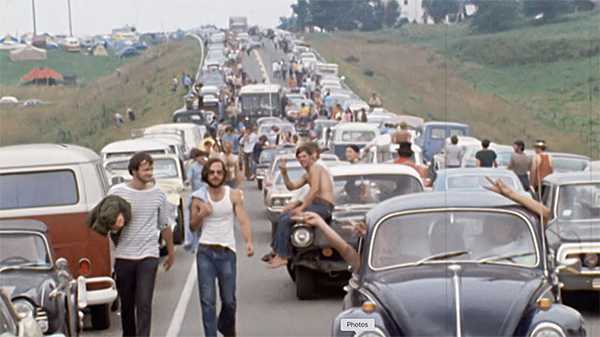
Like the seasoned storyteller he is, documentarian Barak Goodman opens his new film Woodstock: Three Days That Defined a Generation in media res, with the most alarming visuals and most calamitous sound bites he can muster.
“Everything that could possibly go wrong was happening,” we’re informed, as rain clouds darken the teeming throng of 400,000 hippies on Woodstock’s final day, a few of them precariously, and famously, perched amid the towering scaffolding for Mother Nature’s indiscriminate taking.
But there’s a disingenuousness to this overture. Yes, there were storms, and yes, it was dirty, and yes, there were bad trips and sprained ankles and mudslides. But Woodstock was not Altamont, or the misbegotten Fyre Festival; it wasn’t even Woodstocks ’94 or ’99, where musicians where assaulted and hospitalized, and instances of rape and arson killed both the vibe and the brand.
The overarching takeaway from Goodman’s carefully researched oral history is that despite the festival’s rocky road to fruition, and in contradiction to the film’s own ominous preamble, more things went right than wrong. Nobody died at Woodstock, but there were a few births on-site. It rained, but freedom reigned more.
Woodstock, which opened June 21 at Coral Gables Art Cinema prior to its eventual airing on PBS, is part of the network’s American Experience series. Befitting the network’s standards, the film is formally conventional but with a wise distinction: None of Goodman’s countless interviewees appear on camera, even the celebrity faces we might want to see, like David Crosby or Paul Kantner. The director elicited recollections from musicians, the concert’s founders, technicians, staff, local residents of Bethel, N.Y., and of course plenty of attendees, their worlds coloring and elucidating perfectly chosen video of Woodstock before, during and after the event, much of it never seen before. I can’t conjure a more egalitarian way to present the information — or a method more in line with the festival’s democratic precepts.
In this sense, Goodman’s study runs deeper than the previous Woodstock, Michael Wadleigh’s seminal rock doc of 1970. The performances Goodman does include tend to have resonance beyond their skillful delivery: Richie Havens’ “Freedom,” created as a set-closing improvisation whose titular refrain captured the atmosphere in a single word; Joe Cocker’s “With a Little Help From My Friends,” which encapsulated the sense of community that permeated those three days; Jimi Hendrix’s “Star Spangled Banner,” whose metallic paroxysms represented the entire military-industrial complex that lifted the festival’s politics.
Indeed, Goodman recognizes the lightning-in-a-bottle timing of Woodstock, inextricable from the events that hatched it: Vietnam, Nixon, the assassinations of Martin Luther King Jr. and Robert Kennedy. This is, perhaps, why the ’90s iterations failed to capture the fierce vitality of the original: Without the kind of oppressive machine that was most worth raging against, cosseted Gen-Xers were driven less by existential protest than by vacuous nihilism.
Though preceded, Goodman notes, by Monterey Pop and other pioneering festivals, Woodstock was the first example of the concert as commune, where like-minded travelers bonded over more than just music. It’s telling that for so many of Goodman’s sources, the experience bordered on the religious or, ironically enough, the militaristic. For one recollector, concertgoers looked “like pilgrims” traversing the miles-long slog from makeshift parking lot to the festival grounds. Following Friday’s mellow night of folk rock, the masses resembled “an army at rest, before battle the next day.” When food was at its scarcest during the event, and attendees shared cans of baked beans donated from the community, “it was like the loaves and fishes.”
With so many of his interviewees reflecting on the festival from 50 years of hindsight, Goodman can’t help but reinforce the mythology of the festival as a tidy microcosm for an entire generation. But if his film elicits only boomer nostalgia, the rest of us are missing the point. We can learn from Woodstock. Just as the residents of Bethel banded together to prepare and donate whatever food was in their pantries or refrigerators and airlifted it to the starving pilgrims of rock ’n’ roll, be-ins like this can bring disparate groups together even in the most divided of times. When one member of Bethel’s conservative community is asked why she lent a hand to the hippies, she quotes the Bible: “Feed the stranger.”
These moments of grace far outweigh the screaming newspaper headlines meant, at the time, to discredit the festival, i.e., “Nightmare in the Catskills.” Quite simply, Woodstock is so persuasive in its positivity that it fills you with hope.
It remains to be seen whether Woodstock 50, just three months away in upstate New York, will better approximate the original, or the wobblier ’90s reboots. But this, at least, is the movie we need now.
WOODSTOCK: THREE DAYS THAT DEFINED A GENERATION. Director: Barak Goodman; Distributor: PBS; Showing at Coral Gables Art Cinema, with future airings on PBS affiliates